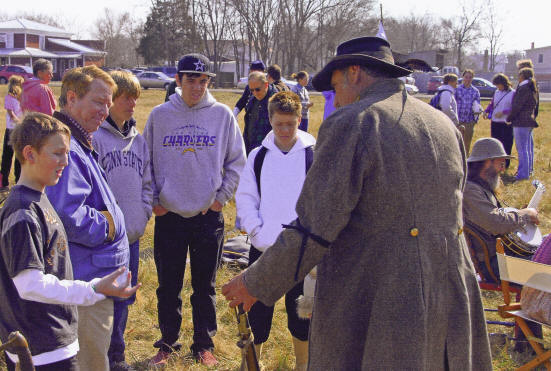|
Three teenage boys from Los Angeles, CA, were surprised to find
a Civil War encampment by the Little Fork Rangers in full
activity when they arrived at the Graffiti House on the morning
of Saturday, February 8th. Charlie, "CJ" and Jack were even
more surprised to learn that the Calvary unit had staged the
encampment to enhance their study of the Civil War in Virginia.
|

Holding the
battle flag of the Little Fork Rangers are,
left to right, Charles Waterman Nicholson, "CJ" Zinn,
and Jack Post. All from California. (Beth Clites Photo)
|
Charlie's mother, Laurie Waterman, was concerned
that her son would not be able to fully comprehend the profound
significance of the Civil War just from reading about it in his
eighth grade textbook 3,000 miles away from where it happened.
She called her longtime friend, Barbara VornDick, a teacher and
resident of Orange County, to ask if she might bring her son and
two of his friends for a weekend to visit some of the local
battlefields and learn about the war experience. Thrilled at the
opportunity to create a dynamic learning experience (a "lesson
plan," if you will) for the boys, Ms. VornDick agreed it was a
great idea to bring the young men to the Culpeper area, which is
so rich in Civil War history.
Having been to Graffiti House many times since it
was opened to the public, Ms. VornDick knew that having the boys
stand in the same rooms, and on the same floors, where
soldiers--some, no doubt, near their age of 14 years--had
recovered from battle wounds 145 years ago would give them a
sense of the human pathos and the struggles of the Confederate
soldiers. That is why Graffiti House was to be the first stop on
their weekend adventure back to the 1860's.
A call was made to the Brandy Station Foundation to ask if
anyone there knew of a re-enactor who might volunteer an hour of
his time to come to the Graffiti House in uniform so that the
boys could see his uniform and weapons, and ask him questions,
as it might make the experience more "real" for them. The BSF
member said she would see what could be arranged, and that they
would call back. About a week later Ms. Della Edrington of the
BSF called Ms. VornDick to say that they had quite a sunrise for
the visiting students. The entire Little Fork Rangers
re-enactors were coming to set up camp at the Graffiti House,
horses and all!

Little Fork Rangers cavalry
practice in front of encampment. (Beth Clites photo)
Ms. VornDick was overwhelmed at this response to her request.
All was kept secret from the boys until they arrived at
Graffiti House Saturday morning and saw the cavalry practicing
formations, and the tents set up in the field in front of the
house. The commanding officer of the Little Fork Rangers
greeted the young men and welcomed them to the camp. The
California party presented the Little Fork Rangers with
home-made hardtack, dried beef, and fruit cobblers; food
authentic to the Civil War period that might have been offered
to soldiers from local residents.

The commanding officer of the
Little Fork Rangers and his
honored guest, Col. Joshua Chamberlain. (Kent
Hufford photo)
The visiting Union officer, Col. Joshua
Chamberlain, was an unexpected thrill, as just that morning his
biography had been displayed along with other Civil War maps and
resources at the VornDick home, and the breakfast conversation
had been sure to include that because while Ms. VornDick's
great-great grandfather had fought for the Confederacy, soldiers
on both sides were to be respected for fighting bravely for
causes they believed to be right.
While details of the encampment had been kept from the
California students, word quickly spread among friends and the
party numbered 15 when all had arrived at Graffiti House on that
brisk, sunny Saturday. A thorough, fascinating tour of the house
was provided by Richard Deardoff, a teacher at Fauquier High
School who had been expecting the boys and greeted them warmly.
A hush fell over the group as Mr. Deardoff pointed out the
signatures and relayed stories about the men who had been in
that very spot over a century ago.

The California students, along with
other visitors, get a history lesson from the Little Forks
Rangers'
commanding officer. From the Confederate officer, to
his left (from right to left), are
Jack Post, CJ Zinn and Charles Waterman Nicholson. (Kent
Hufford photo)
To make the day a multisensory experience for the
Californians, hardtack had been baked and Civil War lunches of
hardtack and dried beef had been wrapped in cloth and packed for
the boys, along with some plain, hot coffee to soften the "tooth
dullers." A CD of Civil War era music played on the car radio on
the way to Brandy Station, and a stop was made at the Rapidan
River to retell one of Stringfellow's spy adventures near the
sight where it happened. Each student had been given a binder
of information about Graffiti House, and the other places they
would visit during their 1860's weekend, and Charlie's mother,
Laurie, made sure that all cell phones, ipods, and electric
gadgets were "confiscated" so that the boys would truly
experience the rich history lessons unfolding before them
without the interruption of modern technology.
Two of Ms. VornDick's children, son Lawton and
daughter Beth, helped facilitate the weekend activities for the
California students. Beth, an archaeological analyst at
Monticello, helped in identifying artifacts and interpreting
historical events.
It was a
wonderful experience for everyone, and all are most grateful to
the Brandy Station Foundation and the Little Fork Rangers for
this fabulous trip back in time. As Charlie said, "This is a day
we will remember for the rest of our lives."
Return to top
Return to Home Page
|